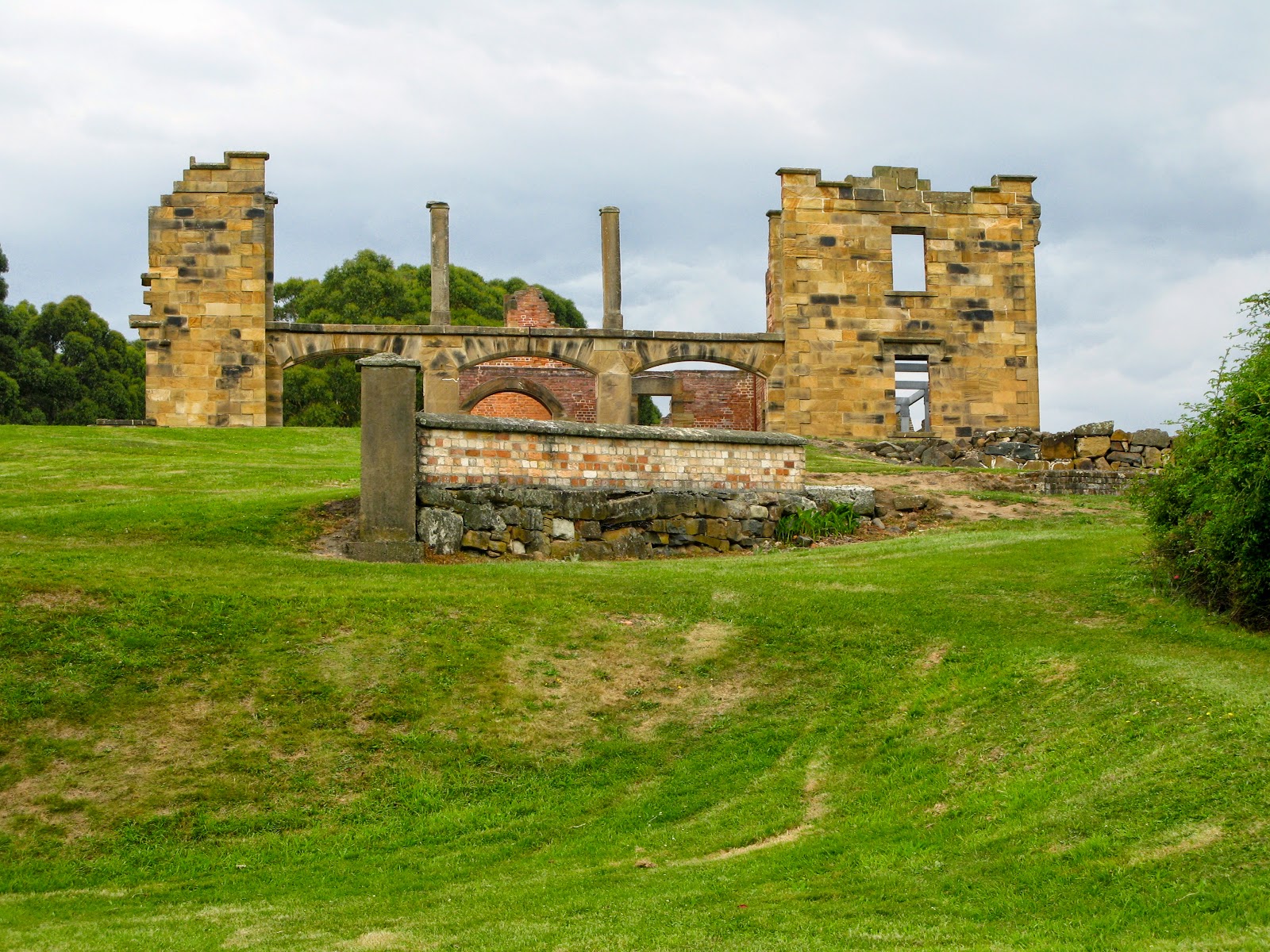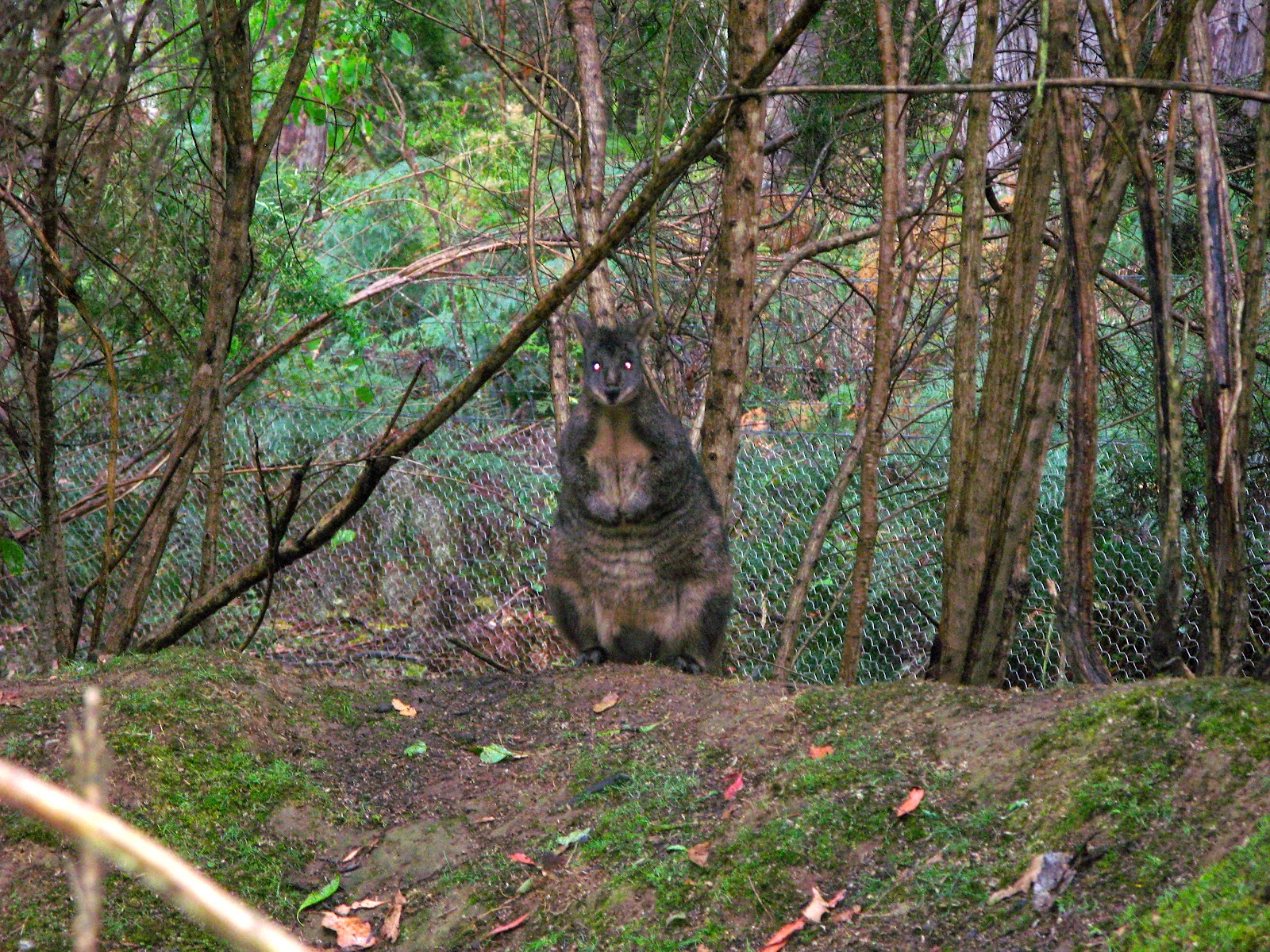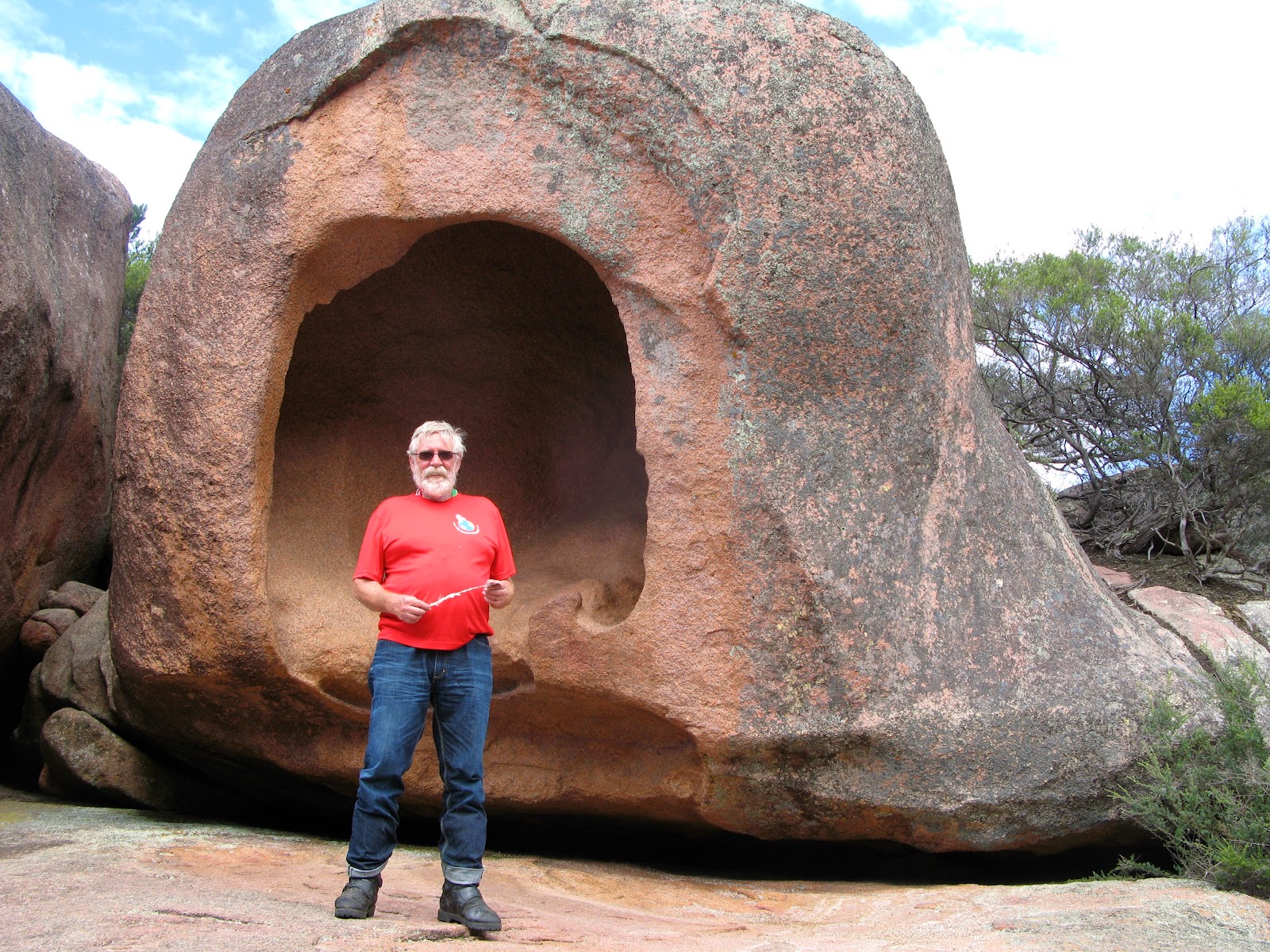I have found this wonderful little community online center in St. Helens, Tasmania. It seems that a group of educators have developed an online center with incredibly fast wi-fi speeds. I intend on taking full advantage of this opportunity and upload a few days of photos and musings.
I seem to be getting into a rhythm of travel which I recognize from other ventures: not too much road time, and time to meet folks, chat it up, and to reflect on this big wide world of ours. Yesterday was indicative of that pattern, with two different guys coming up to me and Roobie to discuss bikes, travel, and all of the rest of it which comes from two strangers meeting. I find that I quickly become the silent witness to a lot of folks' woes and problems. I assume that there is a degree of anonymity with a travelling Canadian. I sometimes find that I find out way too much about peoples' personal lives, simply because I must appear to be a ship passing in the night. All in all, I am finding folks to be overwhelmingly helpful, interested in my travels, and very open to talking about all sorts of world issues.
I moved southerly and ended up in Hobart for a stay in a hostel. It was an opportunity to do some laundry and have a bit of a walkabout of this southern city. I am not sure, but I am guessing that Hobart is pretty close in latitude to Ushuai, in Patagonia. The weather is certainly much warmer than I remember in Argentina.
It was natural to gravitate towards the harbour in Hobart. The city is well-laid out, and it seemed fairly easy to navigate around town. As I toured the docks, I couldn't help but wonder what a grand spectacle it would be when the grand sailboat race between Sydney and Hobart is starting up in the harbour. While there was a suitable number of beautiful old wooden boats, there is also evidence of modern ships which presumably sail the Great Southern Ocean, all the way to Antarctica.
The buildings surrounding the harbour date back to whaling times, and some of them house very classy art shops and restaurants. I had a very interesting conversation with the curator of an aboriginal art shop. He had a deep understanding of the aboriginals of Australia, and it was interesting to hear his comments regarding their history.
These pots are presumably for lobster or crayfish. They are made with a natural wood, and seem much more durable than the wire/plastic prawn traps of home...
The Australian navy has a presence in Hobart. It was interesting to see the kangaroo motif on the stack of the ship..
This old girl was solid wood and just oozed history..
I thought that she was fairly beamy for a large sailer, and apparently one of her lives was spent as a coal barge, which may explain her wide girth.
I can't imagine the skills required to handle these sails and rigging.
I suppose that this would be something my sister would want to climb....
The captain's cabin had a window to overlook the seas...
Quite a contrast between the old and the new. I am sure that an equally qualified crew is needed to run this fine ship as well..
Hobart was the staging point for many expeditions to the Antarctic. This fellow, and his faithful friend Joe, was the first Australian to winter in the Antarctic.
Early 1800 architecture housed many modern shops and restaurants...
I continue to be amazed by the variety of trucks and vans which are heavily modified to face the trekking nature of the Australians. I have seen some wonderfully adapted and self-contained units, worthy of world class travels.
It is necessary to note that Sir John Franklin, who eventually enmeshed his ship and crew in the ice of the Canadian Arctic is also an explorer hero down under. I am in awe of the accomplishments of these early explorers such as Cook and Franklin, who literally travelled the world and mapped it exquisitely, long before Dr. Google and GPS systems.
I have been telling anyone who would listen that I was saint-like, and now I have proof. The sandstone construction was grand, and I had a good wander in the cathedral.
The cathedral has a number of excellent stained glass windows, as well as a significant section celebrating Australian war-dead who were members of this congregation.
The battle-flags of different Tasmanian regiments are hung in honour, in the vestibule of the cathedral.
Across the way, I discovered that the local Chinese community was celebrating Chinese New Year. This visiting monk from China agreed to a photo and a blessing. He had quite an entourage and seemed be revered. I don't know if he was giggling at my appearance, or beaming some good-will.
I noted that both flags have some stars. I will have to look into the history of the Chinese flag to understand the significance of the stars. Somehow I don't think that they represent constellations...
The dragon boat was manned by women, and the enthusiastic crew were clearly pumped by the celebrations.
This little guy was wondering about the Joey, who poked his head out of the bag occasionally.
These guys are for the Armstrong crew...
There were two giant wind mills at the top of this building in the harbour.
This section of the coastline is the so-called "Tessellated Highway." The rock has formed as a result of erosion of particular parts of the the sandstone. The patterns resulting appear to be man-made.
Pirates Bay is a beautiful stretch on the coastline.
The east coast of Tasmania is a fisherman's dream. There are all sorts of species available.
This blowhole was working its way through the wall of the coast.
Along with a couple of thousand Chinese tourists, I entered the famous Port Arthur grounds. The buildings are all that remain of the the penitentiary which was built to house those poor souls kicked out of Britain for a variety of reasons, some criminal, some political, and some downright strange.
The stark remains of the buildings were somewhat somber, and it was difficult to comprehend the pain and suffering which so many souls endured as a result of the imperialistic politics of Great Britain.
This guy seems to be brooding over the many souls who lived and died in these ruins.
This tree is a grand sample of a Norfolk Island pine.
All that remained of the cathedral was the outer walls. A fire had ravaged the building many years before.
The gardens and the buildings were all constructed with convict labour. Clearly the skills required to construct these magnificent monuments were not done by ordinary street louts.
After a walkabout at Port Arthur, I headed down the road to a local Tasmanian Devil sanctuary and zoo...
These squirrel-like creatures scurried about their pens.
This goshawk was pure white, and this was apparently one of the two stages which they will appear.
Feeding time...
Tasmanian Devils are mammals which are scavengers. Those that remain in the wild tend to get on the roads, looking for the large amount of road kill which seems to be everywhere.
I wonder if this guy had every been to Boat Harbour?
Tasmanian Tigers had a bounty on them...and now they are extinct.
Another beautiful example of the Norfolk pine...
9 miles of beaches...
Blue Skies...
We are all artists, some better than others...
Hello Dan and Lisa...
A magical spot: a small bay guaranteed to have had pirates and aborigines meeting for the first time, around a freshwater spring...
Me and my Sea Eagle feather...
A wild camp in Moulting Bay..
These black swans were sought for their feathers and down at one point, and were slaughtered in the thousands for pillows and mattresses...
Some heavy reading to ease me into DreamTime...
Snakes for my Daughter...
A good little local museum...
Some more of those crayfish pots..
There were some awfully big trees in this country.
Should we forget...
I seem to be getting into a rhythm of travel which I recognize from other ventures: not too much road time, and time to meet folks, chat it up, and to reflect on this big wide world of ours. Yesterday was indicative of that pattern, with two different guys coming up to me and Roobie to discuss bikes, travel, and all of the rest of it which comes from two strangers meeting. I find that I quickly become the silent witness to a lot of folks' woes and problems. I assume that there is a degree of anonymity with a travelling Canadian. I sometimes find that I find out way too much about peoples' personal lives, simply because I must appear to be a ship passing in the night. All in all, I am finding folks to be overwhelmingly helpful, interested in my travels, and very open to talking about all sorts of world issues.
I moved southerly and ended up in Hobart for a stay in a hostel. It was an opportunity to do some laundry and have a bit of a walkabout of this southern city. I am not sure, but I am guessing that Hobart is pretty close in latitude to Ushuai, in Patagonia. The weather is certainly much warmer than I remember in Argentina.
It was natural to gravitate towards the harbour in Hobart. The city is well-laid out, and it seemed fairly easy to navigate around town. As I toured the docks, I couldn't help but wonder what a grand spectacle it would be when the grand sailboat race between Sydney and Hobart is starting up in the harbour. While there was a suitable number of beautiful old wooden boats, there is also evidence of modern ships which presumably sail the Great Southern Ocean, all the way to Antarctica.
These pots are presumably for lobster or crayfish. They are made with a natural wood, and seem much more durable than the wire/plastic prawn traps of home...
The Australian navy has a presence in Hobart. It was interesting to see the kangaroo motif on the stack of the ship..
This old girl was solid wood and just oozed history..
I thought that she was fairly beamy for a large sailer, and apparently one of her lives was spent as a coal barge, which may explain her wide girth.
I can't imagine the skills required to handle these sails and rigging.
I suppose that this would be something my sister would want to climb....
The captain's cabin had a window to overlook the seas...
Quite a contrast between the old and the new. I am sure that an equally qualified crew is needed to run this fine ship as well..
Hobart was the staging point for many expeditions to the Antarctic. This fellow, and his faithful friend Joe, was the first Australian to winter in the Antarctic.
Early 1800 architecture housed many modern shops and restaurants...
I continue to be amazed by the variety of trucks and vans which are heavily modified to face the trekking nature of the Australians. I have seen some wonderfully adapted and self-contained units, worthy of world class travels.
It is necessary to note that Sir John Franklin, who eventually enmeshed his ship and crew in the ice of the Canadian Arctic is also an explorer hero down under. I am in awe of the accomplishments of these early explorers such as Cook and Franklin, who literally travelled the world and mapped it exquisitely, long before Dr. Google and GPS systems.
I have been telling anyone who would listen that I was saint-like, and now I have proof. The sandstone construction was grand, and I had a good wander in the cathedral.
The cathedral has a number of excellent stained glass windows, as well as a significant section celebrating Australian war-dead who were members of this congregation.
The battle-flags of different Tasmanian regiments are hung in honour, in the vestibule of the cathedral.
Across the way, I discovered that the local Chinese community was celebrating Chinese New Year. This visiting monk from China agreed to a photo and a blessing. He had quite an entourage and seemed be revered. I don't know if he was giggling at my appearance, or beaming some good-will.
I noted that both flags have some stars. I will have to look into the history of the Chinese flag to understand the significance of the stars. Somehow I don't think that they represent constellations...
The dragon boat was manned by women, and the enthusiastic crew were clearly pumped by the celebrations.
This little guy was wondering about the Joey, who poked his head out of the bag occasionally.
These guys are for the Armstrong crew...
There were two giant wind mills at the top of this building in the harbour.
After leaving Hobart, I headed up the east coast of Tasmania. The road follows the coast-line for the most part, and offers many spectacular views.
This section of the coastline is the so-called "Tessellated Highway." The rock has formed as a result of erosion of particular parts of the the sandstone. The patterns resulting appear to be man-made.
Pirates Bay is a beautiful stretch on the coastline.
The east coast of Tasmania is a fisherman's dream. There are all sorts of species available.
This blowhole was working its way through the wall of the coast.
The stark remains of the buildings were somewhat somber, and it was difficult to comprehend the pain and suffering which so many souls endured as a result of the imperialistic politics of Great Britain.
This guy seems to be brooding over the many souls who lived and died in these ruins.
This tree is a grand sample of a Norfolk Island pine.
All that remained of the cathedral was the outer walls. A fire had ravaged the building many years before.
The gardens and the buildings were all constructed with convict labour. Clearly the skills required to construct these magnificent monuments were not done by ordinary street louts.
After a walkabout at Port Arthur, I headed down the road to a local Tasmanian Devil sanctuary and zoo...
These squirrel-like creatures scurried about their pens.
This goshawk was pure white, and this was apparently one of the two stages which they will appear.
Feeding time...
Tasmanian Devils are mammals which are scavengers. Those that remain in the wild tend to get on the roads, looking for the large amount of road kill which seems to be everywhere.
I wonder if this guy had every been to Boat Harbour?
Further on, up the east coast....
Tasmanian Tigers had a bounty on them...and now they are extinct.
Another beautiful example of the Norfolk pine...
9 miles of beaches...
Blue Skies...
We are all artists, some better than others...
Hello Dan and Lisa...
A magical spot: a small bay guaranteed to have had pirates and aborigines meeting for the first time, around a freshwater spring...
Me and my Sea Eagle feather...
A wild camp in Moulting Bay..
These black swans were sought for their feathers and down at one point, and were slaughtered in the thousands for pillows and mattresses...
Some heavy reading to ease me into DreamTime...
Snakes for my Daughter...
St. Helen's has the great wi-fi center. Chinese miners came to the area, looking for tin.
A good little local museum...
Some more of those crayfish pots..
There were some awfully big trees in this country.
Should we forget...
Lest We forget...
























































































































































